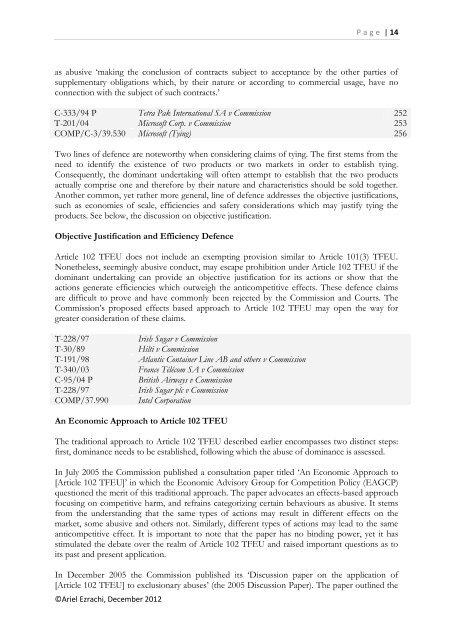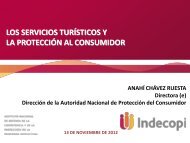EU Competition Law and Policy - compal
EU Competition Law and Policy - compal
EU Competition Law and Policy - compal
You also want an ePaper? Increase the reach of your titles
YUMPU automatically turns print PDFs into web optimized ePapers that Google loves.
©Ariel Ezrachi, December 2012<br />
P a g e | 14<br />
as abusive ‘making the conclusion of contracts subject to acceptance by the other parties of<br />
supplementary obligations which, by their nature or according to commercial usage, have no<br />
connection with the subject of such contracts.’<br />
C-333/94 P Tetra Pak International SA v Commission 252<br />
T-201/04 Microsoft Corp. v Commission 253<br />
COMP/C-3/39.530 Microsoft (Tying) 256<br />
Two lines of defence are noteworthy when considering claims of tying. The first stems from the<br />
need to identify the existence of two products or two markets in order to establish tying.<br />
Consequently, the dominant undertaking will often attempt to establish that the two products<br />
actually comprise one <strong>and</strong> therefore by their nature <strong>and</strong> characteristics should be sold together.<br />
Another common, yet rather more general, line of defence addresses the objective justifications,<br />
such as economies of scale, efficiencies <strong>and</strong> safety considerations which may justify tying the<br />
products. See below, the discussion on objective justification.<br />
Objective Justification <strong>and</strong> Efficiency Defence<br />
Article 102 TF<strong>EU</strong> does not include an exempting provision similar to Article 101(3) TF<strong>EU</strong>.<br />
Nonetheless, seemingly abusive conduct, may escape prohibition under Article 102 TF<strong>EU</strong> if the<br />
dominant undertaking can provide an objective justification for its actions or show that the<br />
actions generate efficiencies which outweigh the anticompetitive effects. These defence claims<br />
are difficult to prove <strong>and</strong> have commonly been rejected by the Commission <strong>and</strong> Courts. The<br />
Commission’s proposed effects based approach to Article 102 TF<strong>EU</strong> may open the way for<br />
greater consideration of these claims.<br />
T-228/97 Irish Sugar v Commission<br />
T-30/89 Hilti v Commission<br />
T-191/98 Atlantic Container Line AB <strong>and</strong> others v Commission<br />
T-340/03 France Télécom SA v Commission<br />
C-95/04 P British Airways v Commission<br />
T-228/97 Irish Sugar plc v Commission<br />
COMP/37.990 Intel Corporation<br />
An Economic Approach to Article 102 TF<strong>EU</strong><br />
The traditional approach to Article 102 TF<strong>EU</strong> described earlier encompasses two distinct steps:<br />
first, dominance needs to be established, following which the abuse of dominance is assessed.<br />
In July 2005 the Commission published a consultation paper titled ‘An Economic Approach to<br />
[Article 102 TF<strong>EU</strong>]’ in which the Economic Advisory Group for <strong>Competition</strong> <strong>Policy</strong> (EAGCP)<br />
questioned the merit of this traditional approach. The paper advocates an effects-based approach<br />
focusing on competitive harm, <strong>and</strong> refrains categorizing certain behaviours as abusive. It stems<br />
from the underst<strong>and</strong>ing that the same types of actions may result in different effects on the<br />
market, some abusive <strong>and</strong> others not. Similarly, different types of actions may lead to the same<br />
anticompetitive effect. It is important to note that the paper has no binding power, yet it has<br />
stimulated the debate over the realm of Article 102 TF<strong>EU</strong> <strong>and</strong> raised important questions as to<br />
its past <strong>and</strong> present application.<br />
In December 2005 the Commission published its ‘Discussion paper on the application of<br />
[Article 102 TF<strong>EU</strong>] to exclusionary abuses’ (the 2005 Discussion Paper). The paper outlined the



